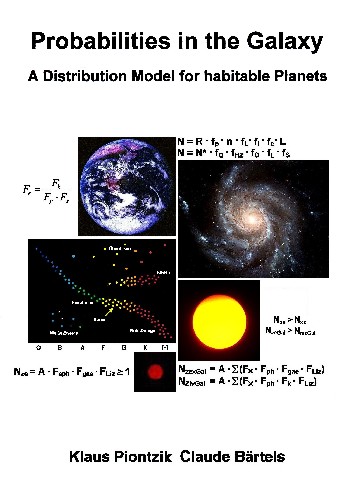| In order to
estimate today what a species would have to be able to
develop into a civilization, only the earth is at our
disposal. Therefore the development on this planet is
considered in this chapter in order to be able to
formulate an estimation of the probabilities. |
| 1) | About 2.4 billion years ago the "Great
Oxygen Disaster" caused by cyanobacteria occurred.
The appearance of free oxygen in the waters of the earth
and the earth's atmosphere was poisonous for the
anaerobic organisms of that time. Most anaerobic animals
were extinguished. Today's, partly controversial, endosymbiont theory states that a phase took place in the prokaryotes (prokaryotes), which had survived the atmospheric change, could develop up to today's cell structure. This was achieved, according to the theory, in which they were incorporated into the developing multicellular (eukaryotes). The "How" is not described! This cell formation is now known as the cell system known to us, as a cell with a nucleus with DNA and incorporated mitochondrium (single cell) with its own cell DNA, with which it lives in symbiosis and multiplies by cell division. This means that each of our body cells is a symbiont of "prehistoric development". So a single cell in the multi cell. Both "energy production systems" (ATP, NADP + / NADPH) [Otto Warburg, 1931] are intertwined and have partly retained their ability to work autonomously. |
| 2) | About 1 billion years ago was the "snowball earth", which is a hypothetical icing of the entire planet during the Erdurzeit in the Neoproterozoikum. This resulted in the formation of eukaryotes, multicellular organisms, and sexual reproduction. |
| 3) | About 80% of all species of animals and plants died, including trilobites (trilobites), but also conodonts or brachopods (caterpillars), about 485 million years ago at the end of Cambrian. Triggers were probably caused by climate change and / or sea level fluctuations. |
| 4) | About 444 million years ago - in the upper Ordovician - there was a mass extinction which affected 50% of all species. It disappeared, among other things. Many Brachiopods. This extinction event is associated with the effects of the radiation of a near-earth supernova. |
| 5) | About 360 million years ago, in the upper Devon, [8] another 50% of all species died because the oxygen content in the water sank. It only survived animals that could adapt themselves or absorb oxygen outside the water. The time of the amphibians had begun. |
| 6) | About 252 million years ago on the Perm-Trias border, 95% of all sea-dwelling species and about 66% of all land-living species (reptile and amphibian species) died. A third of all insects also died out, the only known extinction of insects in the history of the earth. The era of the Therapsids began. These are mammalian-like reptiles. Most scientists today make an extensive flood basin (Trapp), which is formed during volcanic eruptions, responsible for the "Siberian Trapp". |
| 7) | About 200 million years ago, at the end of the triad, 50 to 80% of all species died, among others. Almost all farm animals. It was followed by the age of dinosaurs. Magmafreisations, before the breakup of the Pangea continent, are suspected, or the poisoning of the shallow warm sea-waters by large quantities of hydrogen sulphide, after huge volcanic eruptions had released large quantities of carbon dioxide and sulfur dioxide. |
| 8) | About 50% of all animal species died, including dinosaurs, except for birds, some 66 million years ago on the Cretaceous Tertiary Border (at the same time transition from the Earth's Middle Ages to the Earth New Age). It began the age of the mammals. The cause is the impact of a meteorite. |
| 9) | About 33.9 million years ago, the so-called "Grande Coupure" cooled the global climate, which occurred at the turn of the Eocene / Oligocene (Priabonium / Rupelium border). With related species dying and a change in the fauna, which fell victim to a large part of the primates (master animals), Palaeotheria (early horses), Creodonta (protruding animals) and other animal groups. |
| 10) | About 74 - 75,000 years ago, a genetic bottleneck developed in mankind. As a possible cause the Toba catastrophy theory is discussed by which humanity was reduced to a few thousand people when the Toba volcano erupted on Sumatra (Indonesia). |
| 11) | About 13,000 years ago, since the end of the upper Pleistocene, partly also in the Holocene, the bulk of the Megafauna of America, Eurasia and Australia died out in the course of a quaternary extinction. There are indications of the impact of a meteorite, (or part of a comet), which reduced the large mammals about 13,000 years ago. |
| These are together 11 events, in which the entire biosphere of the earth could have been destroyed. In this respect, one can classify the causes of these events as planetary development dangers. |

|
176 sides, of them 64 in Color 76 pictures 11 tables Production and publishing: Books on Demand GmbH, Norderstedt ISBN 9-783-7528-5524-1 Price: 22 Euro |
|